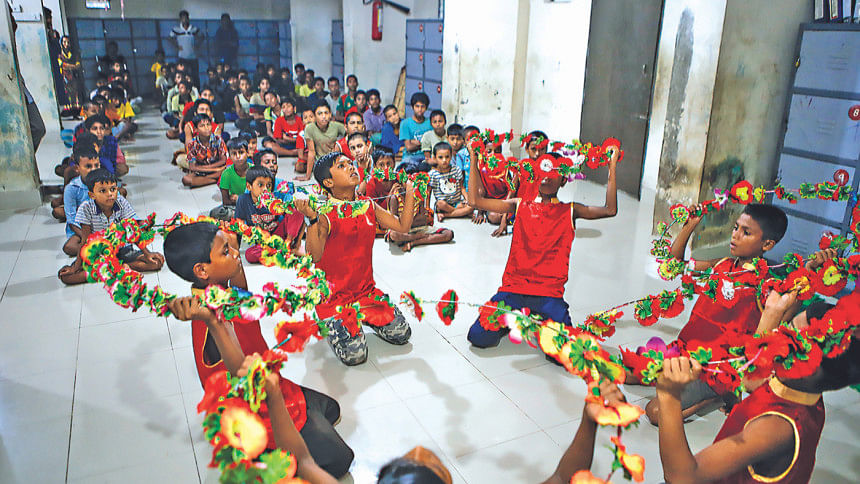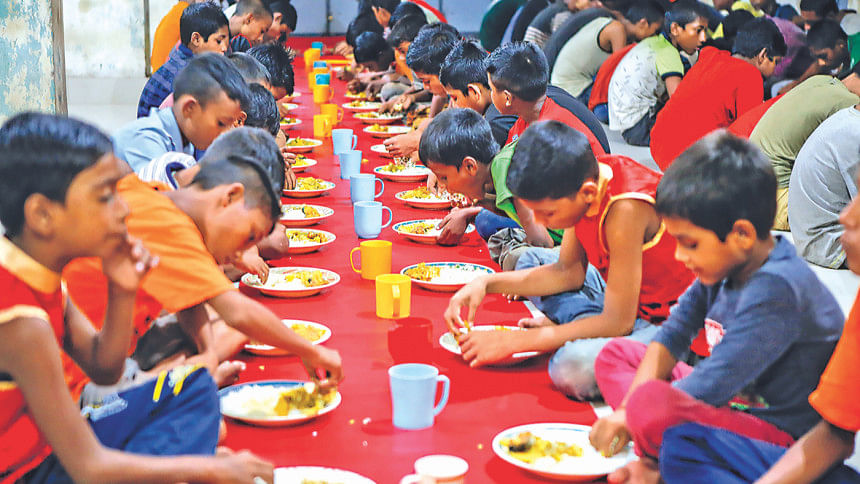Home for the homeless children

A year and a half ago, five-year-old Ashik had to face the harshest reality of his young life. Ashik would live with his parents in Maijdee upazila of Noakhali. After the sudden death of his father, his mother moved back to her village home in Chittagong one day, leaving Ashik alone, and never returned. After crying for months, Ashik got on a train to Dhaka from Maijdee station. Getting down at Tejgaon station, Ashik started to ask people for money and food. At the end of the day, he resigned himself to sleeping at the station.
Ashik soon learned that this was not an easy life, but there was no one to complain to. Within a few weeks, he accepted that he could never have a "normal" life like other children who go to school, learn music or dance, play cricket with their friends, and spend time at home with their families.
By now, Ashik had come to know other street children in the Tejgaon station area. "One day, a man working at the station asked whether I want to live in the government shelter home for children like me. He said they would also give me free food and allow me to go to school for free. I instantly said 'yes'. The next day, the 'sirs' of the shelter home took me here," says Ashik.
Since that day, Ashik has been living in the Street Children Rehabilitation Centre at Karwan Bazar. Alongside this, another centre has also been running in the Kamlapur area of the city for the past three years, under the Street Children Rehabilitation Programme of the Ministry of Women and Children Affairs (MoWCA). Through the centre, Ashik has started going to Islamia Government Primary School in Tejgaon, doing residential coaching, learning dance and music. In his words, "it's a dream life".
There are on average 250 children, between the ages of eight and 16, who once lived in the streets, and now have a home and "normal" life at these rehabilitation centres for underprivileged children. Although the centres were initiated with only a few small rooms, these were expanded as the centres became a sanctuary for street children. The centres are open for any child living on the streets—they can come when they want, take showers, have food four times a day, watch television, and sleep there at night.
"We have staff who go to the stations on a regular basis to invite children to come here. Sometimes, the police call us if they find anyone with no place to live. In fact, if anyone knows about a child with no home, they are welcome to bring them here," says Mamun Bakaul, resident social and health worker of the Kawran Bazar centre. "The children are given some motivational counselling by our counsellors, so that they don't return to the streets. We don't force anyone though—they are given a choice," he adds.

At the centre, the children are kept busy with different activities so that they don't drop out. For example, there is a dance teacher, a music teacher, an art teacher, and an Arabic teacher both for their education and entertainment. "Since it is difficult to send them to schools right away, at first we try to keep them busy with fun and recreational activities. We gradually give them non-formal learning materials in four stages, through our teachers. Later, we admit them in nearby schools. So far, from this centre, we have sent 12 children to the Islamia Government Primary School of Tejgaon," says Mamun.
The children can stay at the centres till they are 18. But the centre tries to convince those who are 12 to 13 years old to get connected with technical and vocational training opportunities. "We try to connect them with Trust Technical Training Institute, financed and run by Bangladesh Army and Underprivileged Children's Educational Programs (UCEP) Bangladesh," says Dr Abul Hossain, project director of the Street Children Rehabilitation Programme of MoWCA. Already, a total of 14 former centre residents have gotten jobs after taking training from the Trust Technical Training Institute, say centre staff.
Both centres have vocational training teachers, who are teaching them crafting and mobile servicing. 11-year-old Shanto took training in mobile servicing and is now planning to set up a small shop of his own. He also learnt to make DIY crafts and has a collection ready for sale. Shanto, who left his home because of his father's inability to maintain his family, wishes to go back home, but only after standing on his own feet.
One of the most important challenges the staff face is in counselling the children who sniff glue, locally known as 'dandy' (used in repairing leather or rubber products). They say that these children leave in a few days as they don't like restrictions, and some even convince other children of the rehabilitation centre to leave with them. "We need to provide long-term counselling to those children," says Mamun.
The ultimate goal of these shelter homes is to find where these children came from and if possible, reintegrate them into their families. As such, around 56 children from the Karwan Bazar and Kamlapur centres have been sent home to their families, with the help of the local administration and law enforcers. Those who don't know their families' whereabouts are provided with training and assistance so that they can make a sustainable living and don't end up returning to the streets.
"We are trying to take on a large project because the flow of children coming to Dhaka from broken families and natural disaster-affected families is not decreasing and that's why we will establish a few more centres," says Dr Hossain. We are also planning to conduct a national survey on street children and try to find out which district or areas have such vulnerable households. After that, we will try to attach them with different programmes of the government."

 For all latest news, follow The Daily Star's Google News channel.
For all latest news, follow The Daily Star's Google News channel. 



Comments